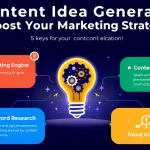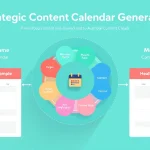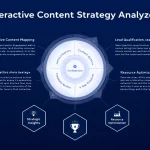Is this tool helpful?
How to Use the SEO Content Strategy Generator Effectively
This tool helps you quickly build a detailed SEO content plan based on your main keyword. Follow these steps for the best results:
- Enter your main keyword in the input box. For example, try “sustainable fashion” or “smart home devices” to start.
- Click the “Generate SEO Content Strategy” button to create a tailored content plan.
- Review the generated content strategy displayed in a clear, organized table that highlights keyword clusters, search intent, and optimized titles.
- Use the “Copy to Clipboard” function to save your strategy for easy use in your content calendar or SEO dashboards.
Understanding the Generated SEO Content Strategy Table
The tool produces a comprehensive markdown table with these five key columns to guide your content creation:
- Keyword Cluster: Groups of related topics centered around your main keyword.
- Keywords: Specific long-tail keywords and related phrases to target.
- Search Intent: Classifies whether the keyword has commercial, transactional, or informational intent.
- Title: Recommended SEO-optimized titles designed to attract clicks.
- Meta Description: Engaging meta descriptions written to fit within optimal character limits.
What Is the SEO Content Strategy Generator?
This tool transforms a single keyword into a structured, actionable content strategy. It uses advanced natural language understanding to group related keywords, clarify searcher intent, and suggest optimized titles and meta descriptions that resonate with your target audience.
Core Features and Capabilities
- Automatic Keyword Clustering: Groups related keywords into relevant topic buckets for easier content planning.
- Search Intent Classification: Distinguishes between informational, transactional, and commercial queries to help you create goal-driven content.
- Optimized Title Suggestions: Generates catchy, SEO-friendly headlines that improve click-through rates.
- Meta Description Creation: Crafts descriptions that are clear, concise, and fit recommended length guidelines.
- Value-Driven Content Ideas: Provides suggestions that focus on delivering real benefits to your audience.
Practical Uses of the Tool
You can apply the SEO Content Strategy Generator in several content marketing scenarios:
Content Marketing Teams
- Plan quarterly editorial calendars efficiently.
- Organize content audits by identifying gaps and opportunities.
- Structure comprehensive topic clusters around core business themes.
SEO Professionals
- Identify high-value keyword opportunities quickly.
- Map competitive content strategies targeting user intent.
- Streamline keyword research by automating clustering and intent detection.
Small Business Owners
- Develop DIY SEO content strategies without needing expert help.
- Analyze market opportunities linked to your niche product or service.
- Plan resource allocation by focusing on keywords that drive clear business results.
Key Benefits of Using This SEO Content Strategy Generator
Save Time and Resources
Manual keyword research and content planning consume hours or even days. This tool reduces research time by up to 80%, letting you:
- Skip manual keyword grouping tasks.
- Focus on crafting content instead of planning.
- Speed up your overall content development process.
Improve Content Relevance and SEO Performance
- Ensure content matches user search intent accurately.
- Create well-structured content clusters that enhance topical authority.
- Boost organic search rankings with optimized titles and meta descriptions.
How the Tool Solves Common Content Strategy Challenges
Organizing Topics and Clusters
You no longer need to manually sift through keyword lists. The tool groups keywords into logical clusters, helping you:
- Plan content pillars that support your SEO goals.
- Identify gaps in your existing content library.
- Build comprehensive topical hubs for better user engagement.
Aligning Content With Search Intent
Knowing user intent is key to content success. This tool classifies keywords by intent to help you:
- Create content that satisfies specific audience needs.
- Increase conversion rates through accurate targeting.
- Deliver better user experience that aligns with search expectations.
Frequently Asked Questions
How many keyword clusters does the tool generate?
The tool generates 10 main keyword clusters. Each cluster includes 7 detailed long-tail keywords or related variations, creating a rich content framework.
Is this tool suitable for different industries?
Yes, it works across all industries and niches. You can generate tailored SEO content strategies for any business or topic.
How should I prioritize the suggested keywords?
Focus first on keywords that align with your immediate business goals. For example, use commercial-intent keywords for driving sales and informational keywords for awareness campaigns.
What defines a good meta description?
A good meta description includes a clear value proposition, a call-to-action, naturally incorporates the target keyword, and stays under 155 characters to ensure full display in search results.
How often should I update my content strategy?
Review your strategy at least every quarter to respond to market shifts and evolving search trends.
Can I export or save the generated strategy?
Yes, use the “Copy to Clipboard” feature to export your strategy into documents, spreadsheets, or content management tools for easy reference and collaboration.
Should I target every keyword variation suggested?
Focus on keywords that fit your resources and business priorities. Prioritize quality and relevance over covering every variation.
How do I measure my content strategy success?
Track organic traffic, keyword ranking improvements, engagement metrics, and conversion rates tied directly to content created using this strategy.
Important Disclaimer
The calculations, results, and content provided by our tools are not guaranteed to be accurate, complete, or reliable. Users are responsible for verifying and interpreting the results. Our content and tools may contain errors, biases, or inconsistencies. Do not enter personal data, sensitive information, or personally identifiable information in our web forms or tools. Such data entry violates our terms of service and may result in unauthorized disclosure to third parties. We reserve the right to save inputs and outputs from our tools for the purposes of error debugging, bias identification, and performance improvement. External companies providing AI models used in our tools may also save and process data in accordance with their own policies. By using our tools, you consent to this data collection and processing. We reserve the right to limit the usage of our tools based on current usability factors.







